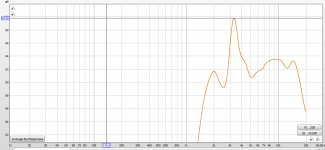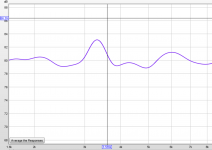Sorry if these questions are dumb, I'm really new to this stuff. I was messing around with the eq yesterday and REW and I noticed how much response changes from close up to a few feet away. For example, here's a 1/6th smoothed close up frequency response of a tweeter that I boosted the 3.3 khz range by a lot, as in 12-13 db I think just for fun. It's pretty obvious.
 Here's the same measurement a few feet away though.
Here's the same measurement a few feet away though.  It's a lot less noticeable on the graph, even though the huge spike is VERY audible. So my questions are 1. Why does this happen? and 2. When I'm equing speakers, should I do it up close or further away for accurate measurements so I don't mess up the response. Also, these measurements were done outside away from any walls, so room modes shouldn't be a factor I think.
It's a lot less noticeable on the graph, even though the huge spike is VERY audible. So my questions are 1. Why does this happen? and 2. When I'm equing speakers, should I do it up close or further away for accurate measurements so I don't mess up the response. Also, these measurements were done outside away from any walls, so room modes shouldn't be a factor I think.
 Here's the same measurement a few feet away though.
Here's the same measurement a few feet away though.  It's a lot less noticeable on the graph, even though the huge spike is VERY audible. So my questions are 1. Why does this happen? and 2. When I'm equing speakers, should I do it up close or further away for accurate measurements so I don't mess up the response. Also, these measurements were done outside away from any walls, so room modes shouldn't be a factor I think.
It's a lot less noticeable on the graph, even though the huge spike is VERY audible. So my questions are 1. Why does this happen? and 2. When I'm equing speakers, should I do it up close or further away for accurate measurements so I don't mess up the response. Also, these measurements were done outside away from any walls, so room modes shouldn't be a factor I think.Right up close, you'll get the driver. Back a little and you'll start to see the speaker as a whole. Move back further and you'll begin to take in the room, if it's there. To answer your question it is better to take your measurements back away from the speaker. When done in a room this is often difficult so many settle on 1-2m.
First, close or far away don't mean nothing, you need to put numbers. This is because close or far are in relation to the driver, speaker and frequencies involved. So what is far for a driver/speaker could not for another one.
Second general remark, speaker measurements not done in an anechoic chamber have to be gated. If not you are measuring also reflections, including the one from mic stand if you are not careful.
Having said that, it is normal that close and far measurement are different. A far measure has a limit of the lower useful frequency imposed by the gate, but no upper limit and it will see the environment, including the baffle effect (baffle step effect and diffraction). On the other hand, a close measurement will go very down in frequency, but is limited on the upper frequency by a combination of driver diameter and closeness. For a tweeter there isn't any practical reason to measure close, and the only meaningful measure is the far one. For a woofer, you need to perform both the far and close measurements, as they will show different part of the driver response.
Note that when mounted in a normal baffle, say 20 cm wide, measuring a tweeter or a small driver 50 cm is already far. I usually measure my speakers at 80 cm.
Ralf
Second general remark, speaker measurements not done in an anechoic chamber have to be gated. If not you are measuring also reflections, including the one from mic stand if you are not careful.
Having said that, it is normal that close and far measurement are different. A far measure has a limit of the lower useful frequency imposed by the gate, but no upper limit and it will see the environment, including the baffle effect (baffle step effect and diffraction). On the other hand, a close measurement will go very down in frequency, but is limited on the upper frequency by a combination of driver diameter and closeness. For a tweeter there isn't any practical reason to measure close, and the only meaningful measure is the far one. For a woofer, you need to perform both the far and close measurements, as they will show different part of the driver response.
Note that when mounted in a normal baffle, say 20 cm wide, measuring a tweeter or a small driver 50 cm is already far. I usually measure my speakers at 80 cm.
Ralf
Right up close, you'll get the driver. Back a little and you'll start to see the speaker as a whole. Move back further and you'll begin to take in the room, if it's there. To answer your question it is better to take your measurements back away from the speaker. When done in a room this is often difficult so many settle on 1-2m.
I took these measurements outside though. Shouldn't the microphone be picking up what my ears can hear? I can hear the spike regardless of whether I'm close to the tweeter or a meter or so away. It doesn't seem to make a difference to me, but the microphone sees things differently.
First, close or far away don't mean nothing, you need to put numbers. This is because close or far are in relation to the driver, speaker and frequencies involved. So what is far for a driver/speaker could not for another one.
Second general remark, speaker measurements not done in an anechoic chamber have to be gated. If not you are measuring also reflections, including the one from mic stand if you are not careful.
Having said that, it is normal that close and far measurement are different. A far measure has a limit of the lower useful frequency imposed by the gate, but no upper limit and it will see the environment, including the baffle effect (baffle step effect and diffraction). On the other hand, a close measurement will go very down in frequency, but is limited on the upper frequency by a combination of driver diameter and closeness. For a tweeter there isn't any practical reason to measure close, and the only meaningful measure is the far one. For a woofer, you need to perform both the far and close measurements, as they will show different part of the driver response.
Note that when mounted in a normal baffle, say 20 cm wide, measuring a tweeter or a small driver 50 cm is already far. I usually measure my speakers at 80 cm.
Ralf
"A far measure has a limit of the lower useful frequency imposed by the gate, but no upper limit and it will see the environment, including the baffle effect (baffle step effect and diffraction). On the other hand, a close measurement will go very down in frequency, but is limited on the upper frequency by a combination of driver diameter and closeness." Sorry you lost me a little there, what do you mean by upper and lower limits?
So the peak is less noticeable from a distance because of the enclosure it's in?
A far field measure has to be gated in order to eliminate the room effect, and all what is not coming from the speaker itself. The gate has the effect to remove the bass frequencies, and the result it that a gated measure is valid only above a specific frequency (determined by the gate length). Just as an example, with my setup I can't see what happens below roughly 200-250 Hz, so this is my lower useful frequency, and my upper useful frequency is 20KHz and is determined by the measurement gear (mic/preamp/sw).Sorry you lost me a little there, what do you mean by upper and lower limits?
If you want to know what happens below this low useful frequency, you need to perform a close measure. With the 200-250Hz example above, this is needed only for mid and woofers. In this case the mic should be placed at few mm from the cone, and the mic will hear only the driver and not what happens at the speaker border. But you will have an upper limit of the useful frequencies, because when you exceed this limit, the sound coming to the mid from different part of the driver will not be in phase anymore (wavelength is inversely proportional to frequency), and you start to see dips that aren't there in the reality. The upper limit is dependent from the radiating surface and for a 6.5" driver with a 5" radiating surface is some 850Hz. In this case a close measure is valid from 10-20Hz to roughly 850Hz.
Ralf
I can tell you right now that compact, inexpensive, all in one stereos or "boomboxes" don't come close to delivering the claimed power. I've reverse engineered a few "tabletop hi-fis" and if they claim 50 watts a channel, it's actually more like 12 watts a channel. They can sometimes deliver brief transients close to their rated power, but not continuously.
It's not that 12 watts continuous with 6 dB headroom isn't a lot; it's probably more than you think. It's the ridiculous marketing claims that you shouldn't believe that will mislead you.
It's not that 12 watts continuous with 6 dB headroom isn't a lot; it's probably more than you think. It's the ridiculous marketing claims that you shouldn't believe that will mislead you.
- Home
- Loudspeakers
- Multi-Way
- Changing frequency response with distance
